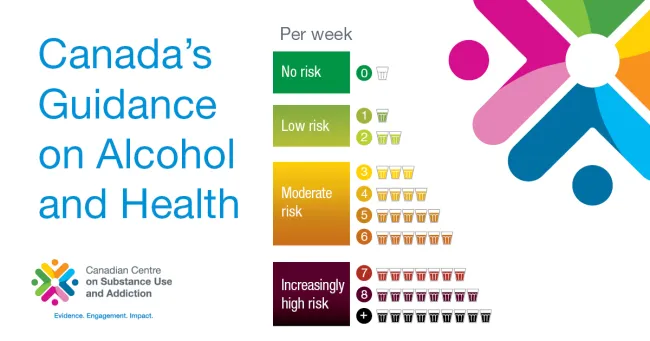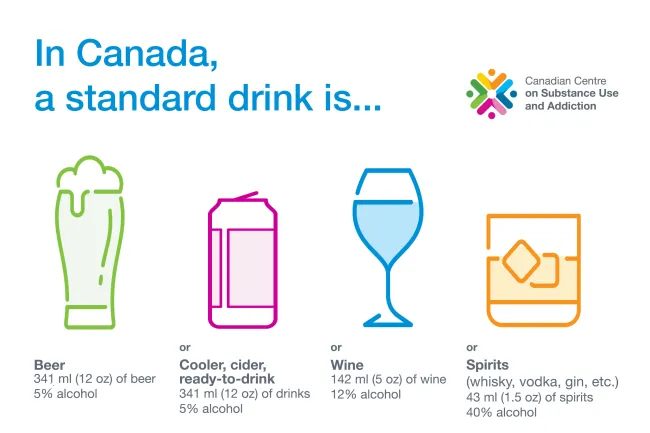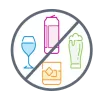Why drink less? Drinking less lowers your risks
New research shows a strong association between drinking and an elevated risk to your health, including premature death from a wide range of diseases and other alcohol-caused harms. No amount of alcohol is good for your health. It doesn’t matter what kind of alcohol it is — wine, beer, cider or spirits. That’s why if you drink, consider drinking less.

Drinking alcohol creates a continuum of risk. Your lifetime risk for health issues, injuries, social issues and premature death increases as the amount of alcohol you consume increases. It continues to add up over a lifetime.
The continuum of risk associated with weekly alcohol use where the risk of harm is:
- 0 drinks per week — Not drinking has benefits, such as better health, and better sleep.
- 2 standard drinks or less per week — You are likely to avoid alcohol-related consequences for yourself or others at this level.
- 3–6 standard drinks per week — Your risk of developing several types of cancer, including breast and colon cancer, increases at this level.
- 7 standard drinks or more per week — Your risk of heart disease or stroke increases significantly at this level.
- Each additional standard drink radically increases the risk of alcohol-related consequences.
We know that many people will still choose to drink alcohol after learning this information. Like all health information, it’s your right to know. Something good to know about this evidence is that every drink counts: any reduction in alcohol use has benefits. That’s why Canada’s Guidance on Alcohol and Health’s main recommendation is simply this: To lower your risks, think about reducing the amount of alcohol you drink.
If you are going to drink, don’t exceed 2 drinks on any day. Drinking less benefits both you and others. It reduces your risk of injury and violence, and many health problems that can shorten life.
What’s a Standard Drink?

It can be hard to know what a “standard drink” means. The measurement of a standard drink varies in different countries. Different types of drinks and popular container sizes contain different amounts of alcohol. It’s important to keep in mind how many “standard drinks” are in the beverages you consume to understand how much alcohol you’re drinking. A standard drink is calculated by both drink size and the percentage of alcohol in it.
The measurement of a standard drink varies in different countries.
In Canada, a standard drink is:
- a bottle of beer, 341 ml (12 oz.), 5% alcohol;
- a can of cider, 341 ml (12 oz.), 5% alcohol;
- a glass of wine, 142 ml (5 oz.), 12% alcohol; or
- a shot glass of spirits, 43 ml (1.5 oz.), 40% alcohol.
Consider Drinking Less
You can reduce your drinking in steps! Remember, any reduction helps lower your health risks. Every little bit counts.
There are simple things that can help you drink at a level that’s right for you:
- Stick to the limits you’ve set for yourself.
- Drink slowly.
- Drink lots of water.
- For every drink of alcohol, have one non-alcoholic drink.
- Consider alcohol-free or low-alcohol beverages.
- Eat before and while you’re drinking.
- Explore alcohol-free weeks or do alcohol-free activities.
If you’re concerned about your drinking, ask a healthcare professional for help.
Demographics and Alcohol
Alcohol and Sex and Gender
Health risks increase more quickly at 7 or more standard drinks per week for females. Overall, far more injuries, violence, and deaths result from men’s drinking.
Alcohol and Trying to Get Pregnant, Pregnancy or Breastfeeding
When trying to get pregnant or during pregnancy, there is no known safe amount of alcohol use. When breastfeeding, not drinking alcohol is the safest.
Alcohol and Youth
Drinking is a leading cause of death and social issues in young people.
Intoxication is associated with:
- High risk of injuries,
- Aggression and violence,
- Dating violence and
- Worsening academic performance
Youth under the legal drinking age should delay drinking for as long as possible.

When Zero Is the Limit
In some circumstances, not drinking alcohol is safest. For example, when:
- Driving a motor vehicle;
- Using machinery and tools;
- Taking medication or other drugs that interact with alcohol;
- Doing any kind of dangerous physical activity;
- Being responsible for the safety of others; and
- Making important decisions.
About Canada’s Guidance on Alcohol and Health
In January 2023, the Canadian Centre on Substance Use and Addiction (CCSA) published Canada’s Guidance on Alcohol and Health to provide people living in Canada with information to make well-informed decisions about their alcohol consumption.
The development of Canada’s Guidance on Alcohol and Health followed a rigorous and transparent approach to assess the impact of various levels of alcohol use on disabilities and deaths from a wide range of diseases and other alcohol-caused harms. Its analyses were conducted by a panel of 23 experts from 16 different organizations, based on the most recent data and methods.
Learn more about Canada’s Guidance on Alcohol and Health
